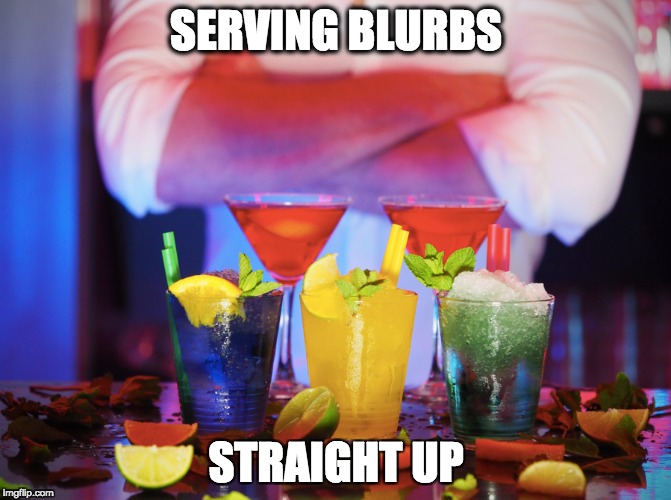
If the cover is an invitation to the party in your book, then the blurb (the back cover description, the summary, whatever you want to call it) is the RSVP card readers check off as attending-with-the-chicken-option when they buy your book.
The trouble is that for so many books, while the cover is invites you to a rave, the blurb reveals it’s really polka night at the VFW.

The Book Cover
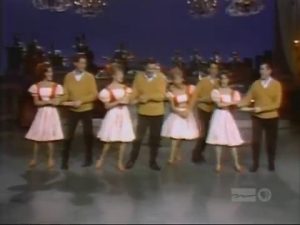
The Blurb
So, if the blurb is so important, why is it so hard to write? Raise your hand if you hate writing blurbs. Raise your other hand if you agonize over writing a blurb, and it still feels like it’s awful when it’s done.
Even Tolstoy probably downed a gallon or two of vodka while trying to write the blurb for War and Peace.
Well, for today’s Girl Friday, you get me, Cait Reynolds (you know, the chick who goes on vacation with six books and comes back with, uh, eighteen – no lie!), and my tips and tricks for turning blurb writing hell into blurb writing heaven!
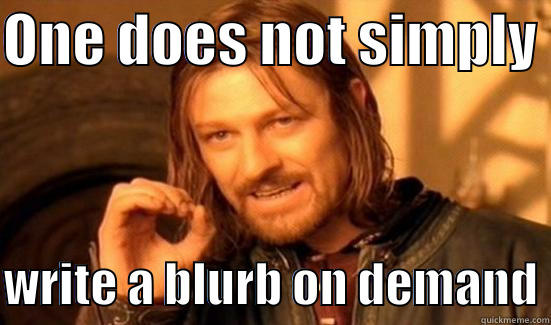
Actually, *I* do.
I used to hate blurb writing with the heat of a thousand suns. Now, I pop them out like Pop-Tarts from a toaster. I used to think blurbs were a challenge set by the Devil (totally on par with that 40 days in the desert thing) to test my resolve in being a writer. Now?
The Lord rewards the righteous, and the way of blurb writing is littered with goodness and manna with sprinkles.
Why is blurb writing so hard?
In order to fully understand the solution, we have to look at the problem.
We write a book. We are so freaking excited about it! It’s such a good story! We want everyone to know what a good story it is! It has all these characters and a quest that is going to change the world! Oh, and then, there’s this really crucial part about…
…aaaaand that’s where we need to stop.
We have come down with a serious case of “KSS” – Kitchen Sink Syndrome. It’s probably safe to say that we have also contracted a secondary infection of “ISS” – Inadvertent Snowflake Syndrome.
The symptomology of Kitchen Sink Syndrome is easy to spot:
- The urge to make sure the entire arc of the plot is covered;
- Reassuring the reader that there will be a satisfying resolution;
- Showing just how exciting the story is by revealing one of the twists;
- Erupting in a rash of “No Character Left Behind” in the description.
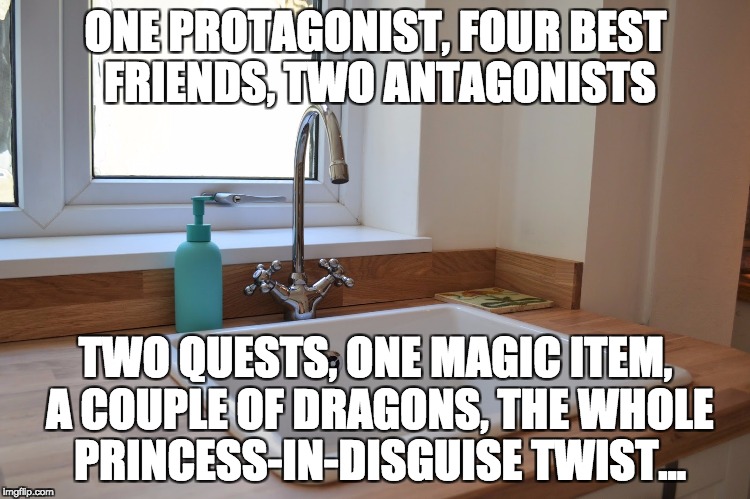
If we can check off one or more of these symptoms, then we definitely need to get tested for Inadvertent Snowflake Syndrome, just to be on the safe side.
Signs of ISS include:
- Mentioning the age of any character unless crucial to the plot;
- Including irrelevant physical descriptors (I’m looking at you, raven-haired beauty!);
- Reassuring the reader that the protagonist has best friends who will go with him/her on the quest;
- Admitting that any characters fall in love with a 70% chance of happily ever after.
So, now we have a diagnosis that on the surface seems to nix basically anything we want to put in the blurb. It feels like we are further away than ever from that golden moment of revelation of how to write a blurb with ease and panache.
Yet, like chicken soup, antibiotics, and puppy-snuggling, there is a slow-and-steady cure for the blurb-writing blues.
Celebrity Death Match: Blurbs vs. Summaries
The first thing we have to do is stop thinking of the blurb as a stand-in for a synopsis or summary of the book. Stop thinking like a writer, and start thinking like an advertiser.
A summary tells all, reveals all, and has a purpose that is totally different from a blurb. It’s an editorial and production piece that rarely sees the light of day with the public.
A blurb is an advertisement. It’s meant to lure, entice, and tease. It is a selling tool.

And, just like most effective selling tools, absolute accuracy isn’t really necessary. Think of the blurb like it’s an ad for wrinkle cream (Thanks, Kristen!).
It will leave your skin softer and smelling good. Whether your skin is smoother or not is entirely subjective, so the claims of the ad can’t really be proved or disproved.
What I’m trying to say is that we can fudge things a little bit in a blurb if it will make it more exciting and enticing. For example, if Seraphina is learning to become a mage but ends up flunking out of mage school and not being a mage after all, we don’t really have to be honest and up front with the reader in the blurb that Seraphina will fall short of her goals and our expectations.
Just like the old saying, “There are no good lawyers, only lawyers who do their job well,” there are no good blurbs, only blurbs that do their job and sell the reader on the book.
Hokey Pokey blurbs
Good blurbs leave us wanting to know more, thinking about the problem posed, or fascinated with one little detail that was mentioned.
These are the things that lead us to buy the book. I totally get that it is wicked hard to pry ourselves out of the mindset of a being a writer and and into the slightly swampy mindset of being a marketer. So, here’s a little game I play when I sit down to write a blurb:
The Hokey Pokey.
You put your protagonist in. You leave the best friend out. You put the problem in. You leave the twist out. You do the Hokey Pokey and leave ’em on a cliffhanger. That’s what it’s all about.
(Look, I never said I was a poet or good at rhyming stuff.)
Obviously, there are exceptions and tweaks for every genre, and it’s a good practice to browse through both indie and traditionally published books in whatever genre we are writing to study the blurbs. Things to note as we read the blurbs:
- How long are they?
- How suspenseful?
- What are some key words and phrases in the genre?
- Do they start with a tagline (a one-sentence/sentence fragment that is a tease for the entire book)?
- Do they end with a tagline?
- What is the balance between the protagonist’s personal peril and the global peril of the plot?
If we look hard enough, patterns for the blurb emerge (kind of like those 3-D eye puzzles I could never get to come into focus). In all seriousness, the structure of a blurb is super simple and can be summed up by 3P’s made of 2-3 sentences each:
- Protagonist: Who are we rooting for and where are they in life when the book starts?
- Problem: What is the main problem of the book?
- Peril: How does the problem bring the protagonist to the brink of X?
And leave it there. Don’t reassure the reader about anything. EVER. Reassurance is what they get when they buy the book and read it all the way through.
Which is why we write the blurb in the first place…
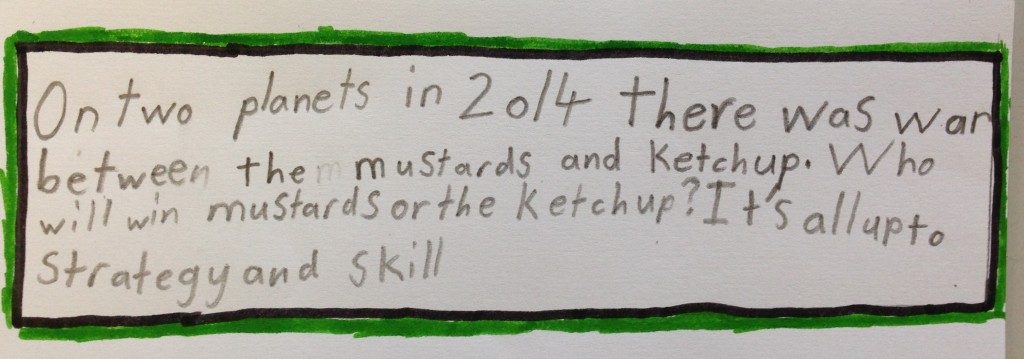
I’m not gonna lie. The kid has talent. I kinda want to read this. (From Mrs. Baldwin’s Class Blog – http://mrsbaldwin5.edublogs.org/2014/08/14/what-is-a-blurb/)
Blurb writing blows…but, it doesn’t have to
If you want to learn more about writing blurbs and get your blurb workshopped, join my class tonight!
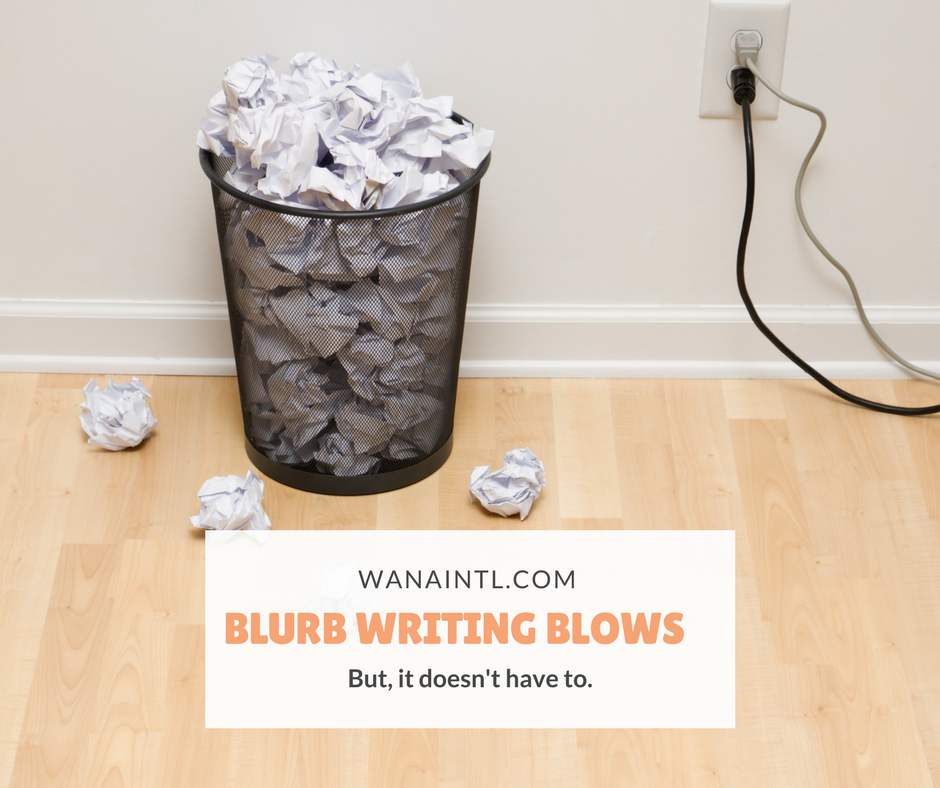 Instructor: Cait Reynolds
Instructor: Cait Reynolds
Price: $45.00 USD
Where: W.A.N.A. Digital Classroom
When: Friday, October 6th, 2017. 7:00-9:00 p.m. EST
The blurb. Back cover description. 150-200 words. Your entire book in 3 small paragraphs.
The heart’s cry goes up from every single writer ever: “THIS IS HARDER TO WRITE THAN THE 90,000 WORDS OF MY BOOK!”
And yet, it shouldn’t be. Approached from a different angle, a blurb should be one of the easiest and most fun things to write. Yes. I went there. I said it. Hopefully, after taking this class, you will be saying it, too. No more blubbering over blurbs. Ever.
This class will cover:
- Understanding the purpose of a blurb in attracting readers;
- The top secret formula to structuring a blurb;
- How to plug-and-play every blurb, every time;
- Why everything you think is important in your story really isn’t (in terms of the blurb);
- The secret to keywords, blurbs, and algorithms.
As a bonus, bring a copy of your blurb to the class for group workshopping!
A recording of this class is also included with purchase.
GOLD PACKAGE
With the Gold Package, you get a 1 hour consult and hands-on blurb editing session with Cait!
About the Instructor:
 Cait Reynolds is a USA Today Bestselling Author and lives in the Boston area with her husband and four-legged fur child. She discovered her passion for writing early and has bugged her family and friends with it ever since. When she isn’t cooking, running, rock climbing, or enjoying the rooftop deck that brings her closer to the stars, she writes.
Cait Reynolds is a USA Today Bestselling Author and lives in the Boston area with her husband and four-legged fur child. She discovered her passion for writing early and has bugged her family and friends with it ever since. When she isn’t cooking, running, rock climbing, or enjoying the rooftop deck that brings her closer to the stars, she writes.








16 comments
4 pings
Skip to comment form
I often try to write my blurb early in the story process. I find that it helps me determine if my story is clearly defined or wandering. Thanks to Kristen, I strive to describe my story in a single sentence. If I can’t do that then I know there is not a clear plot and it needs more work. While a single sentence is not a blurb, it helps me define what the blurb should look like and makes it easier to write.
Great post and very timely since an agent asked me to send her a blurb on my book. Very helpful. All the best, Kat.
A book blurb isn’t altogether so different than what screenwriters call a logline. The logline is a selling tool, too. For an in-depth piece on the art of the logline, see this post.
Man, I wish you’d posted this before I went through all the anguish of writing the blasted thing!
Happily, I think I’ve wound up with a fairly hokey-pokey draft:
“Princess, pawn – or queen?
Princess Lily was born to be queen of Arcelia, where the land itself has life and magic growing in it. Yet she leads a pawn’s existence in the shadow of her guardians’ control. She dreams of the day when she will take her rightful place in the world.
At last her chance arrives, with a quest for the three Requisites of Restoration Day, the royal rite which renews the life of the land. But she’s been hidden away too long…
Stripped of all she thought was hers, Lily will need to do more than cross the board if she is to emerge triumphant as the queen she knows she must be. The land becomes both field and prize in a gripping game – and this time she’s playing for her life.”
Thanks for the useful tips! (Although I now have the Hokey Pokey stuck in my head…)
It’s nice to hear that I’m not the only hater of the blurb 🙂
I start writing my book blurbs early in the writing process, using the book’s plot as the basis (thesis) of the blurb and then work to develop the hook and cliffhanger over the course of writing the book. Then when it comes time to include the blurb, it has been refined and edited over a course of months, not days.
I read tons of these on Amazon before write no my first one. They do follow a pattern, at least in the romance genre.
Still, it took me a long time to match my work to the formula. Not sure why. I think part of it is practice. I’ve only ever written one!
This is great advice! May I share your hokey pokey on my blog?
Excellent. Thank you!
Marvelous. You touched the agonizing pressure points for me.
These are great tips for writing blurbs. Your class sounds wonderful.
Hi Cait. I missed this class. Will you be holding it again? In the near future (I hope)?
Author
Hi Jana, I will be offering the blurb class again soon – just have to figure out a date. But, don’t worry! We’ll let everyone know via the blog! Thanks 😀
Argh. I missed the class. May I register as a late student and receive the predated material? Please??
I think Cait is re-listing the class because of demand.
Many hours later, I rewrote the blurb:
Merryn really didn’t want to steal the Book of Pordicion but with the magic runes on it weakening it was only a matter of time before the god trapped in its pages awakened. The six elvin adapts said the runes would hold…
[…] via The Book Blurb—An Invitation Readers Simply Can’t Turn Down — Kristen Lamb […]
[…] https://authorkristenlamb.com/2017/10/the-book-blurb-an-invitation-readers-simply-cant-turn-down/ How important are blurbs? I write them before I write the book. I find it a lot easier to do it this way, plus you can use the blurb as a guideline for your story. There will be deviations, things happen during the righting but you can pull it back or rewrite it in the end. […]
[…] Writing the book blurb can be one of the hardest tasks writers face. Cait Reynolds demystifies the book blurb. […]
[…] class. In it, I will show you all my secret tips and tricks (even beyond what I wrote in this blog post) to painlessly writing those crucial 150 words that will SELL YOUR […]